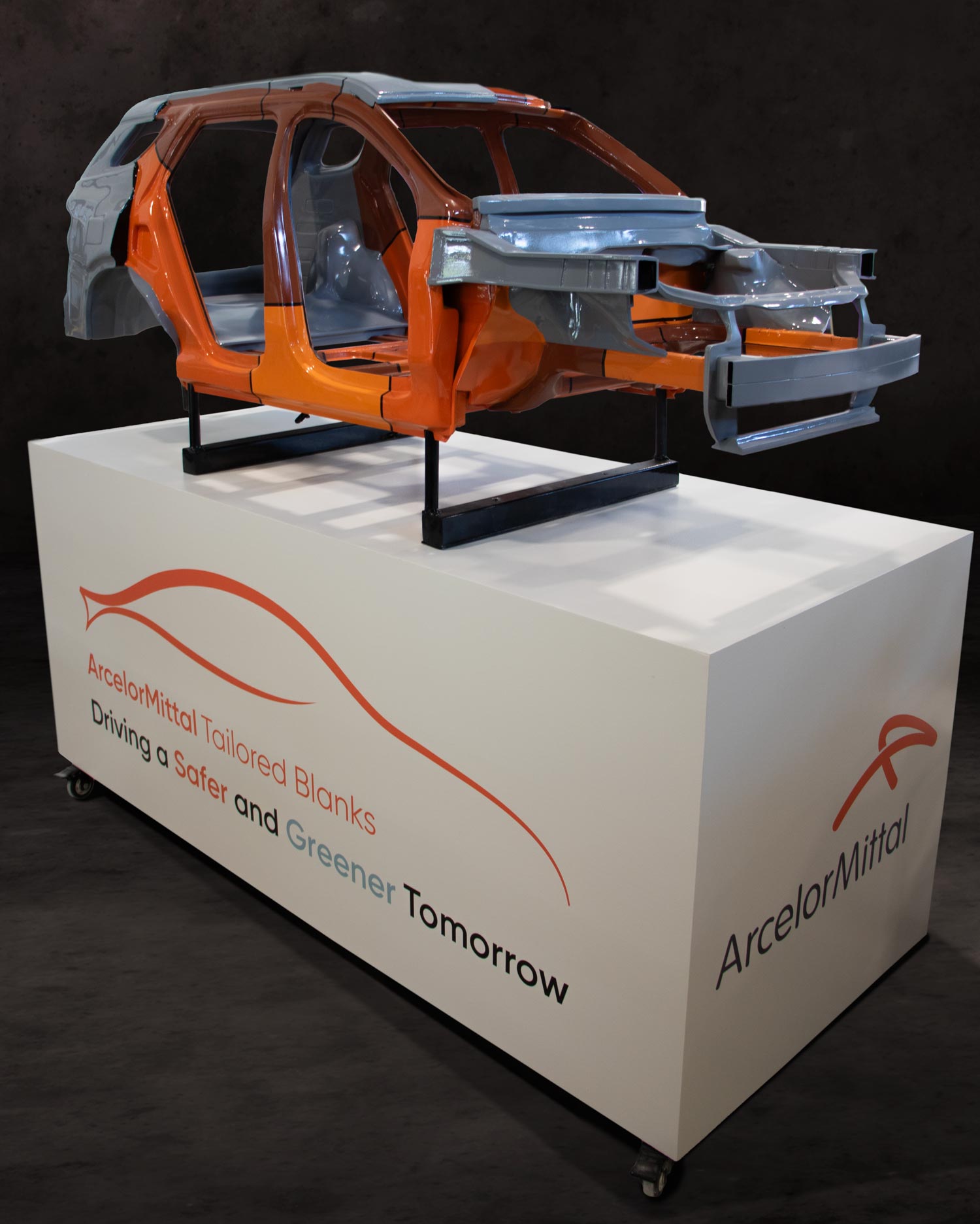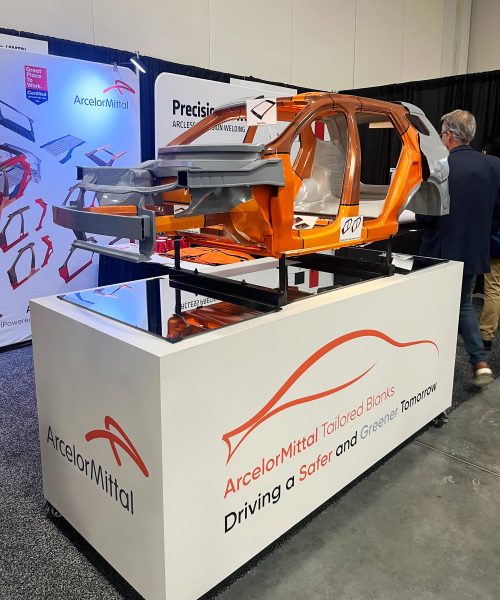Vehicle Frame Replica
Vehicle Frame Replica
We Build Custom 3D Replicas
Crafting a 3D-Printed Masterpiece: The Making of a Tailored Blank Vehicle Frame Replica for ArcelorMittal
Innovation in the automotive industry is not only about building the next great vehicle but also showcasing cutting-edge technology and engineering in ways that capture the imagination of enthusiasts, investors, and professionals alike. This was exactly the case with the 3D-printed replica of a Tailored Blank Vehicle Frame for ArcelorMittal, a renowned global steel and mining giant. The replica was revealed at a high-profile auto conference in Detroit, drawing attention for its blend of engineering excellence and artistic craftsmanship.
This blog dives into the fascinating process of creating this vehicle frame replica, exploring the materials, techniques, and tools used to bring the vision to life. It’s a confirmation to how digital fabrication can merge with traditional manufacturing to create functional art that serves as both a marketing asset and a demonstration of technical expertise.

The Significance of the Tailored Blank Vehicle Frame
Before diving into the intricate details of the replica, it’s important to understand the significance of the vehicle frame itself. Tailored blanks are sheets of steel that are laser-welded together, combining different thicknesses and strengths of steel in a single component. These blanks allow automakers to design lighter, safer, and more cost-effective vehicles. ArcelorMittal, being a leader in advanced steel solutions, employs this technology to help car manufacturers meet stringent fuel efficiency standards and reduce overall vehicle weight without sacrificing structural integrity.
The Tailored Blank Vehicle Frame showcased by ArcelorMittal in Detroit wasn’t just an ordinary part of a car. It was a symbol of innovation, precision, and the future of automotive manufacturing. Creating a 3D-printed replica of this frame wasn’t merely a task—it was a challenge to accurately represent the intricacies of the design while also meeting the aesthetic and functional requirements of a display piece for a global audience.
3D Printing: A Fusion of Art and Engineering
3D printing has revolutionized industries by allowing creators to translate complex designs into physical objects with high precision. For this project, the technology was leveraged to produce a visually compelling replica of the Tailored Blank Vehicle Frame that would not only look impressive but also convey the technical sophistication of ArcelorMittal’s products.
The process of building the frame replica started with creating a highly detailed digital model. This model included every element of the frame’s design, from the varying thicknesses of steel to the complex weld seams. Engineers and designers worked together to ensure that every curve, angle, and connection was represented as accurately as possible. The digital model needed to capture both the structural properties and the aesthetic qualities of the frame, highlighting its innovative nature.
Once the digital model was finalized, it was prepared for 3D printing. This step involved translating the model into a series of instructions that could be understood by the 3D printer. Layer by layer, the printer constructed the replica from a specialized polymer material, chosen for its durability and ease of post-processing. While the final product would not be made of steel, the polymer provided enough strength and flexibility to create a faithful representation of the original frame.

The Challenges of Scale and Detail
One of the key challenges in this project was the sheer scale of the vehicle frame replica. At its core, the vehicle frame was a large and complex structure, with numerous interconnected parts and intricate details. Translating this into a 3D-printed replica required a deep understanding of both digital modeling and physical manufacturing constraints.
To address this challenge, the replica was printed in sections, each of which was carefully aligned and assembled to create the final product. This modular approach allowed the team to maintain a high level of detail in each section while also managing the overall size of the project. Once printed, the sections were sanded, painted, and finished to ensure a cohesive appearance.
The final assembly was a delicate process, as each section had to fit together perfectly without visible seams or gaps. This required precision not only in the 3D printing process but also in the post-production finishing work. The goal was to create a replica that looked as though it was made from a single piece, despite being constructed from multiple parts.
From Concept to Reality: Showcasing Innovation in Detroit
When the 3D-printed replica of the Tailored Blank Vehicle Frame was finally revealed at the auto conference in Detroit, it made a powerful impression. The frame was displayed prominently, surrounded by ArcelorMittal’s branding and information about the company’s cutting-edge steel solutions. Attendees marveled at the craftsmanship and attention to detail, and many were intrigued by the combination of advanced manufacturing techniques and traditional craftsmanship that had gone into creating the piece.
For ArcelorMittal, the replica was more than just a display item. It was a visual representation of their expertise in materials engineering and a demonstration of their ability to deliver innovative solutions to the automotive industry. By showcasing the frame in this way, the company was able to communicate the value of tailored blanks in a tangible, accessible format.
The replica also served as a conversation starter, encouraging discussions about the future of vehicle manufacturing and the role of advanced materials in shaping that future. It highlighted the importance of lightweight, high-strength materials in improving fuel efficiency and reducing emissions, key goals for automakers around the world.

The Role of Collaboration and Craftsmanship
One of the most important aspects of this project was the collaboration between engineers, designers, and fabricators. Each member of the team brought a unique set of skills and expertise to the table, and it was this collaborative effort that allowed the project to succeed.
Engineers played a critical role in ensuring that the digital model was accurate and true to the original design of the vehicle frame. Designers focused on the aesthetics of the replica, ensuring that it would look visually compelling and attract attention at the conference. Fabricators and craftsmen worked to bring the digital model to life, using a combination of 3D printing, CNC machining, and hand finishing to create a product that was both functional and beautiful.
This collaboration extended beyond the creation of the replica itself. Throughout the project, the team worked closely with ArcelorMittal to ensure that the final product aligned with the company’s vision and goals. Regular communication and feedback loops helped to keep the project on track, and the result was a stunning display piece that exceeded expectations.
Conclusion: A Masterclass in Precision and Innovation
The creation of the 3D-printed Tailored Blank Vehicle Frame replica for ArcelorMittal was a masterclass in precision, innovation, and craftsmanship. From the initial concept to the final product, every step of the process was carefully planned and executed to deliver a piece that not only represented the technical expertise of ArcelorMittal but also captured the attention and imagination of those who saw it.
By combining advanced manufacturing techniques like 3D printing and CNC machining with traditional craftsmanship and hand finishing, the team was able to create a product that was both functional and visually stunning. The replica served as a powerful marketing tool for ArcelorMittal, showcasing their commitment to innovation and their leadership in the field of advanced materials.
At its core, this project was about more than just creating a display piece—it was about pushing the boundaries of what is possible in manufacturing and design, and using those possibilities to tell a compelling story about the future of the automotive industry.
Checkout WhiteClouds’ 3D Replicas to learn more about Replicas.
Contact us today to learn more about our 3D services and how we can help you achieve your goals
